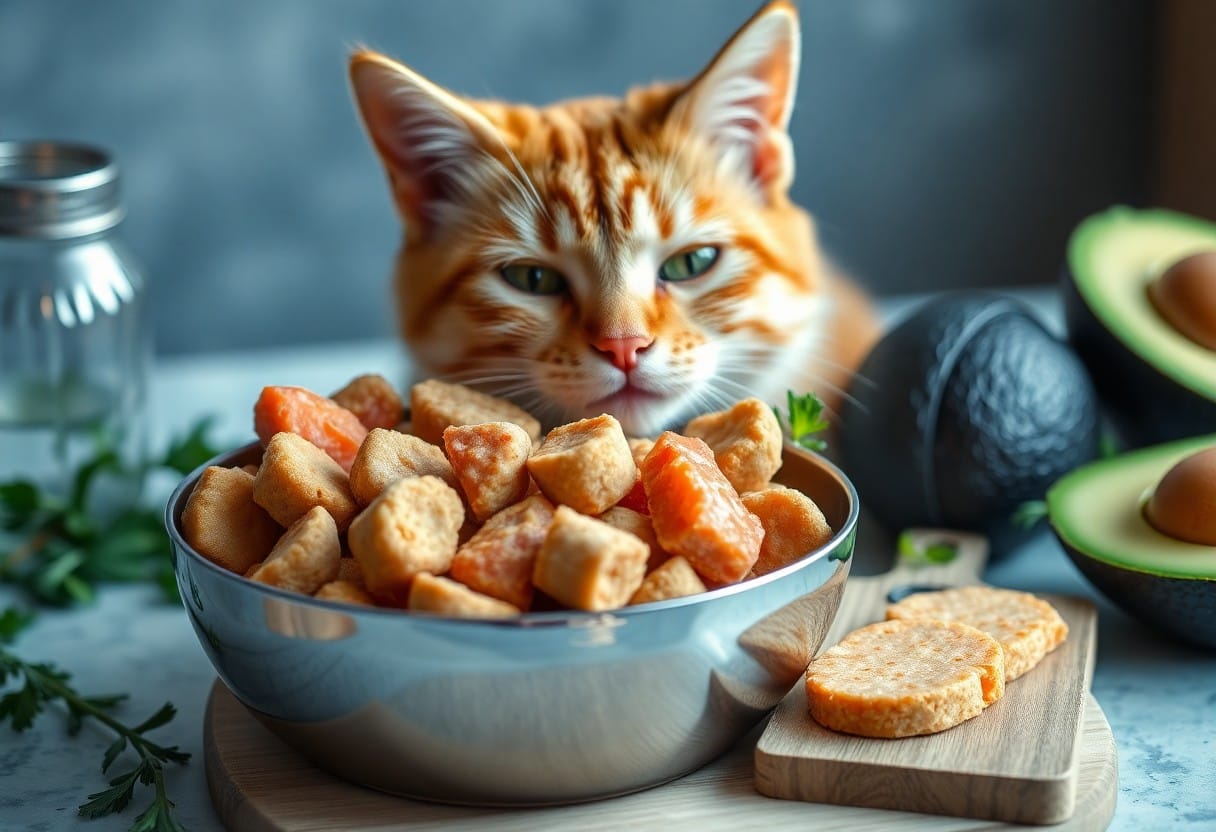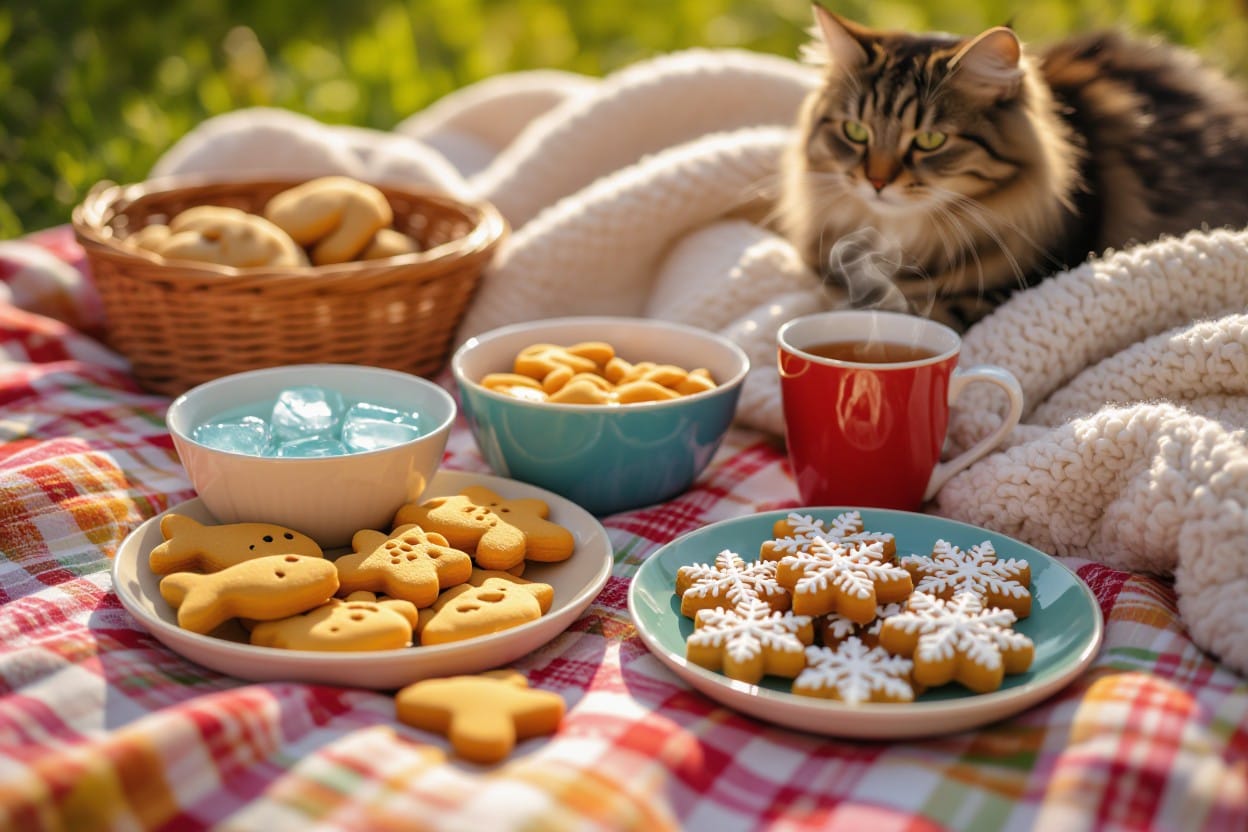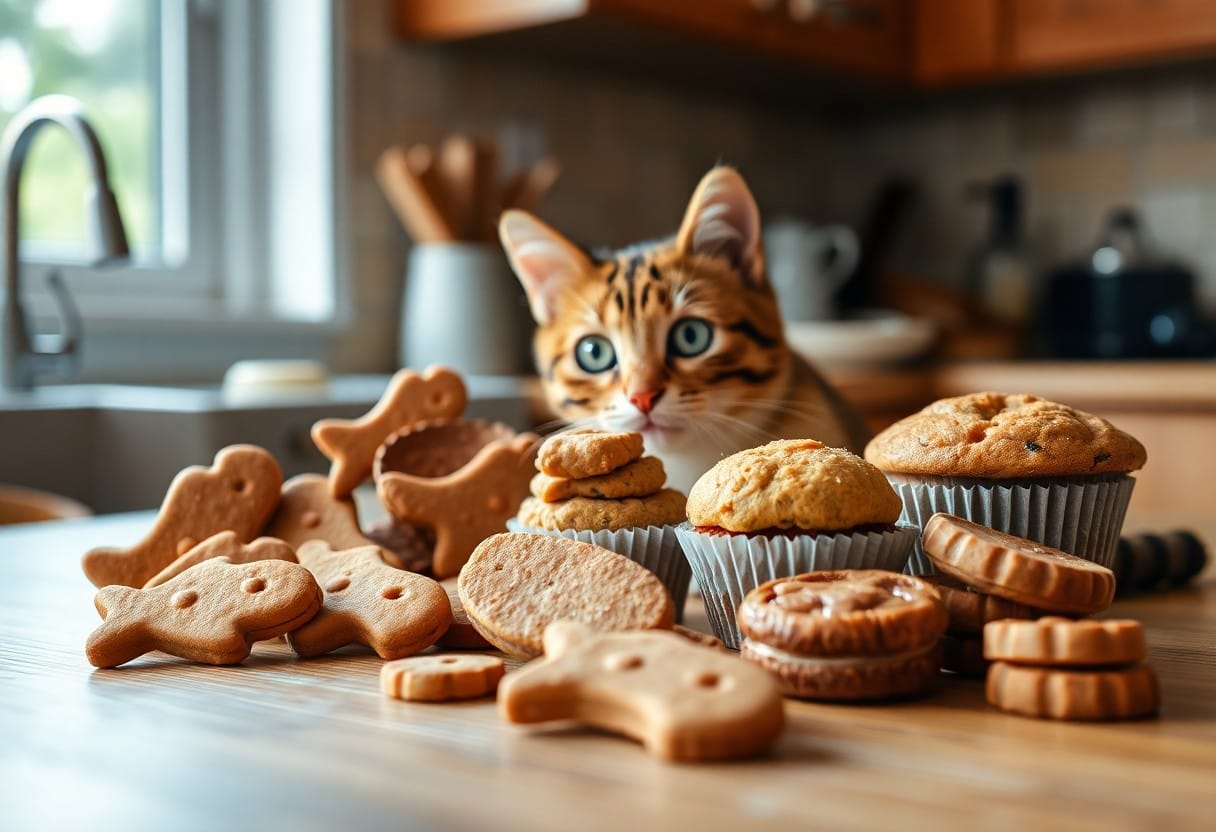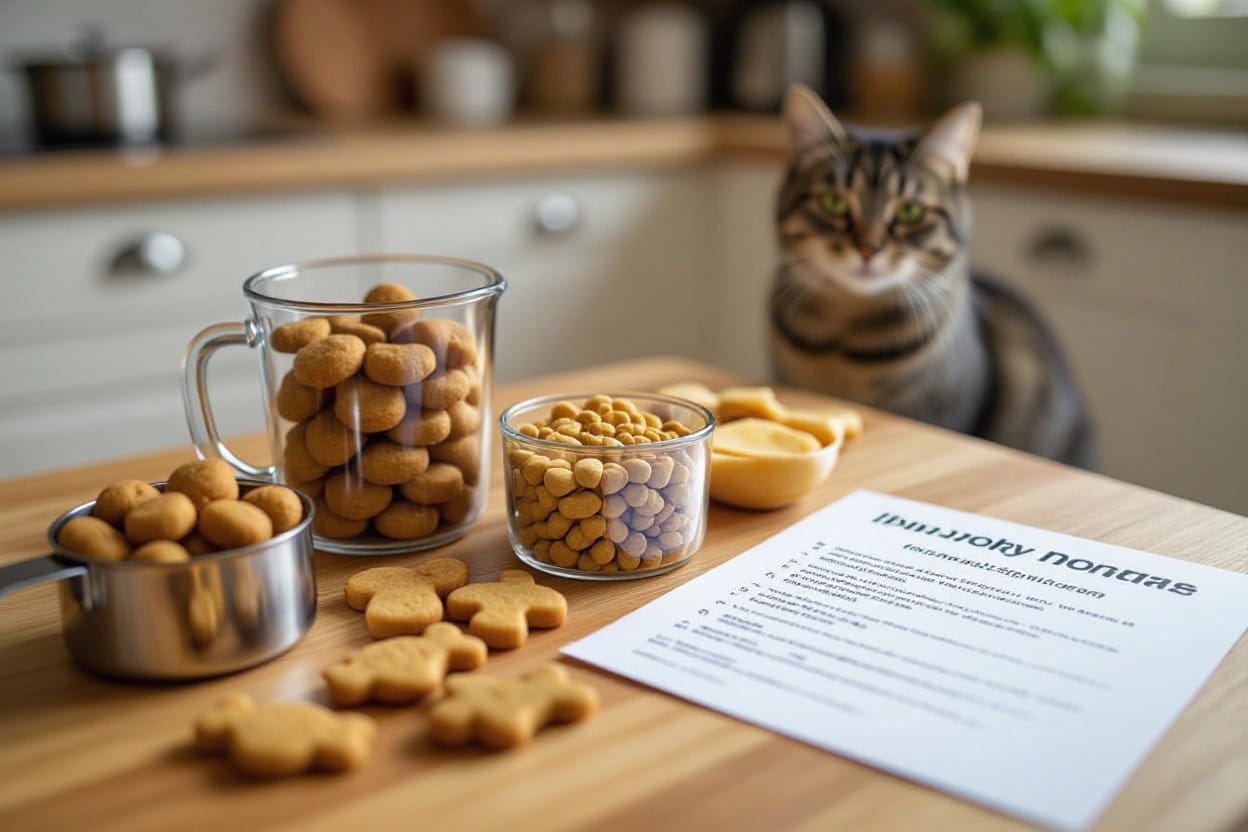Transforming Common Pantry Staples into Cat Delicacies
Simple pantry staples can be elevated to gourmet treats for your feline companion. For example, oatmeal can be cooked and mixed with a bit of tuna juice to create a hearty snack that’s packed with fiber. On the other hand, plain pumpkin (not the spiced pie filling) is rich in fiber and can aid digestion, making it a great addition to homemade cat treats. A small amount of peanut butter — only if your cat isn’t allergic — blended with oats can form a delightful and crunchy treat as well. Always ensure that any ingredient used is safe for your pet, fostering both flavor and health in every bite.
Key Takeaways:
- Common ingredients like chicken, fish, and certain fruits can be elevated into gourmet cat snacks with minimal effort.
- Incorporating herbs such as catnip or parsley can enhance flavor and provide health benefits for your feline friend.
- Understanding your cat’s dietary needs and preferences is crucial in crafting safe and enjoyable snacks at home.
Unconventional Ingredients that Cats Adore
Many pet owners might overlook common pantry items that can delight your furry friend. Embracing unconventional ingredients not only diversifies your cat’s diet but also introduces them to new flavors and textures. By combining everyday items with a touch of creativity, you can craft gourmet snacks that are both nutritious and tantalizing. Think outside the box, and your feline companion will surely thank you!
Fruits and Veggies: Surprising Favorites
Cats are obligate carnivores, but that doesn’t mean they won’t appreciate the occasional fruit or vegetable treat. Safe options like pumpkin, carrots, and blueberries can provide an unexpected burst of flavor and important nutrients. You might find that your cat enjoys a bit of sweetness from these natural goodies, especially when prepared in a fun way, such as purees or tiny bites.
Herbs and Spices: Aromatic Enhancements
Herbs and spices can elevate your culinary creations for your cat, adding an aromatic twist. Many cats enjoy flavors like catnip, which can elicit amusing and playful behavior. Other safe herbs, such as parsley and mint, can provide interesting sensory experiences and health benefits. Both herbs not only spark curiosity but may also assist in digestion, keeping your cat healthy and happy.
Incorporating herbs and spices into your cat’s snacks can draw them in with enticing scents and flavors you’re likely to have on hand. For example, a sprinkle of catnip on a simple chicken treat might turn an ordinary snack into a delightful feast. Similarly, blending a bit of parsley with cooked chicken could entice your feline, providing both flavor and potential digestive support. By using these aromatic enhancements, you can ensure each snack is not just a meal but an experience, making mealtime something to look forward to for your pet.
The Science of Nutrition: Making Homemade Cat Snacks Healthy
Creating homemade cat snacks allows you to tailor the nutrition to your feline’s needs, promoting overall health and wellness. Understanding the basic components of nutrition can help you provide treats that not only taste good but also offer valuable benefits. Incorporating ingredients that align with your cat’s dietary requirements will result in snacks that fuel their energy and satisfy their cravings, giving them the perfect combination of indulgence and nourishment.
Essential Nutrients for Feline Wellness
Your cat’s diet should include a mix of proteins, fats, vitamins, and minerals to support their health. Cats are obligate carnivores, meaning they require protein from animal sources to thrive. Essential nutrients, such as taurine, play a vital role in healthy vision and heart function. Additionally, incorporating omega-3 fatty acids from fish can improve coat health and support cognitive function.
Balancing Treats with Daily Diet
Finding the right balance between your cat’s daily meals and snacks helps avoid overfeeding and maintains a healthy weight. Treats should comprise no more than 10% of your feline’s daily caloric intake. By calculating your cat’s total caloric needs based on their weight, age, and activity level, you can effectively incorporate homemade snacks without disrupting their balanced diet. For instance, if your cat requires 200 calories a day, limit their treats to about 20 calories, ensuring they remain an enjoyable addition rather than a dietary concern.
Balancing treats effectively means considering the nutritional composition of both meals and snacks. If a treat is rich in calories, adjust the amount of kibble or wet food accordingly to prevent weight gain. Aim to rotate different homemade snacks to expose your cat to a variety of flavors and nutrients while sticking to a controlled portion size. By keeping a close eye on their overall diet, you’ll not only provide enjoyable indulgences but also cultivate good habits that support your cat’s health and well-being.
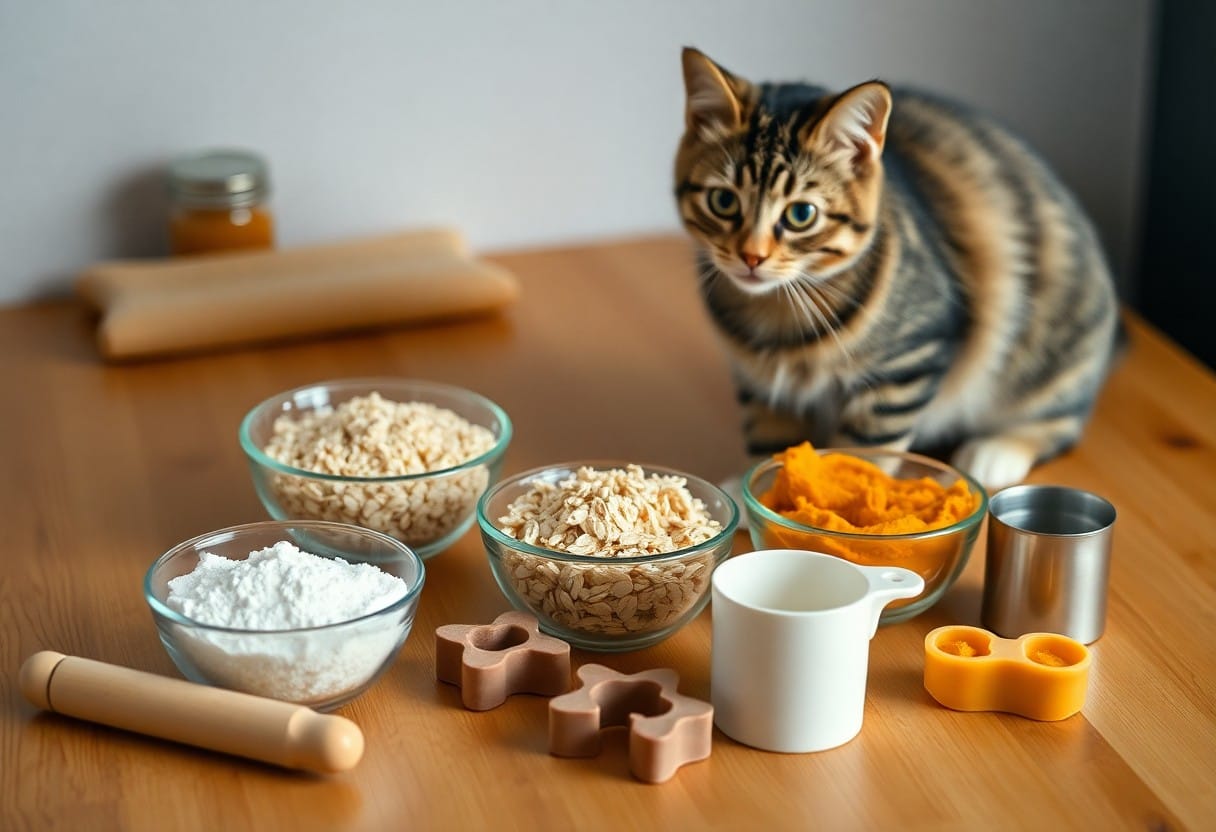
Crafting Cat Treat Recipes from Scratch
Creating cat treats from scratch not only ensures your feline receives wholesome snacks, but also allows you to customize flavors and textures to their liking. With simple recipes, you can whip up delicious snacks using ingredients you already have at home. Your cat will appreciate the genuine love and effort you put into crafting these delightful surprises!
Simple Step-by-Step Recipes
| Recipe | Ingredients |
|---|---|
| Chicken Bites | 1 cup cooked chicken, 1/2 cup oat flour, 1 egg |
| Tuna Treats | 1 can tuna, 1/2 cup whole wheat flour, 1 egg |
| Cheesy Delights | 1 cup grated cheese, 1/2 cup oat flour, 1 egg |
Creative Flavor Combinations to Try
Experimenting with unique flavor pairings can open up a world of gourmet snacks for your cat. Incorporate ingredients like salmon and pumpkin or chicken and mint to pique their interest and provide nutritional variety.
Think outside the box with flavor combinations that combine protein and subtle herbs. For instance, mixing turkey with sweet potato introduces healthy carbs, while blending cod with parsley offers omega fatty acids and fresh breath benefits. As you create these treats, always observe your cat’s reactions and tailor future recipes to their preferences. Not only will these innovations keep your kitty engaged at snack time, but they can also contribute to their overall health and wellness.
The Art of Presentation: Turning Snacks into Gourmet Experiences
Elevating your cat’s snacks into a gourmet experience lies in the art of presentation. Simple treats can become lavish dinners with a bit of creativity. Serve your homemade snacks in stylish bowls or on a rustic wooden platter, and add garnishes like fresh catnip or a sprinkle of powdered chicken. The visual appeal encourages curiosity and heightens the feeding experience, making mealtime a delightful occasion for your cat.
Stylish Serving Ideas and Packaging Tips
Using attractive serving methods can transform your kitty’s snacks into an enticing meal. Consider these ideas:
- Opt for elegant ceramic or wooden dishes that match your home decor.
- Package treats in decorative glass jars tied with ribbons for a fresh gift.
- Layer the snacks in a tiered dessert stand for a buffet-style feast.
- Use colorful napkins or dishcloths to create a themed dining setup.
Thou can craft an experience that turns ordinary snacks into extraordinary treats.
Engaging Your Cat’s Senses for Maximum Enjoyment
Capturing your cat’s attention requires stimulating all their senses. Incorporate a variety of textures and flavors into their snacks to provoke curiosity. Cats are particularly drawn to crunchiness, so mixing soft treats with crunchy ones heightens excitement. Additionally, serving snacks at different temperatures, such as slightly warmed treats, can entice their aroma and flavors while resonating with their instinctual preferences. Experimenting with combinations of scents and textures will encourage playful engagement and enhance their overall dining pleasure.
Consider including aromatic herbs known to intrigue cats, like catmint or thyme; these can enhance the sensory experience. Using small food puzzles to present treats engages their problem-solving instincts while challenging their brains. Utilize flavors your cat loves, like tuna or chicken, alongside unique pairings like pumpkin or sweet potato, which provide both nutrition and novelty. Ultimately, a multi-sensory experience will ensure your kitty relishes every bite. Thou can elevate snack time into an engaging feast that they eagerly await each day.
From Kitchen to Cat’s Paw: Practical Considerations for Homemade Treats
Making homemade cat treats requires more than just a recipe; it involves careful thought about the ingredients and their effects on your furry friend. Factors like ingredient quality, preparation methods, and ensuring a balanced diet play significant roles in creating snacks that are both delicious and nutritious. You want to keep your cat’s preferences and dietary needs in mind while also considering how to simplify the process. A well-planned approach can turn your kitchen into a feline snack haven, filled with gourmet delights that your cat will love.
Safety First: Foods to Avoid
Certain ingredients can be harmful to cats and should always be avoided. Foods like chocolate, onions, and garlic can lead to serious health issues. Even seemingly harmless items like grapes and raisins can cause kidney failure. It’s wise to familiarize yourself with the list of foods that are toxic to cats. Prioritizing safety in snack preparation ensures that your homemade treats contribute positively to your cat’s well-being.
Storage and Shelf-Life of Homemade Treats
Homemade cat treats have a different shelf-life compared to store-bought options, largely due to the absence of preservatives. For optimal freshness, you can store your treats in an airtight container, either at room temperature for short-term use or in the refrigerator for a longer life, usually around 5-7 days. For extended storage, consider freezing them. Properly sealed, treats can last up to three months in the freezer, making it convenient to whip out a tasty snack anytime your cat deserves a gourmet treat.
When storing homemade cat treats, ensure they are completely cool before sealing to prevent condensation, which can lead to spoilage. Clear labeling with dates can help you keep track of freshness. Use small, resealable bags for portion control, making it easy to thaw only what you need at a time. If you notice any changes in smell, texture, or appearance, it’s best to err on the side of caution and dispose of the treats. After all, your cat’s health is paramount, and nothing beats the enjoyment of a safe and scrumptious snack.
Conclusion
Drawing together your everyday ingredients can truly elevate your cat’s snack experience into something luxurious. By utilizing accessible items like chicken, fish, or even pumpkin, you can create enticing treats that your feline friend will adore. Not only does this allow you to control the quality and freshness of the snacks, but it also fosters a deeper bond between you and your pet. So, get creative in the kitchen and delight your cat with gourmet-style snacks that show just how much you care!
Q: What everyday ingredients can be transformed into luxurious cat snacks?
A: You can use a variety of everyday ingredients to create delightful snacks for your feline friend. Options include cooked chicken, tuna, pumpkin puree, plain yogurt, and sweet potatoes. These ingredients are not only commonly found in most kitchens but also provide important nutrients. Combine them with some cat-friendly herbs like catnip or parsley for added flavor and health benefits.
Q: How can I ensure the snacks I make are safe for my cat?
A: To ensure the safety of your homemade cat snacks, it’s vital to avoid ingredients that are toxic to cats, such as onions, garlic, chocolate, and certain artificial sweeteners like xylitol. Always do thorough research on any new ingredient you plan to use. Additionally, you should introduce any new treats gradually, monitor your cat for any adverse reactions, and consult your veterinarian if you have any doubts about specific foods.
Q: What are some simple recipes for transforming these ingredients into snacks?
A: Here are a couple of easy recipes to try:
1. Chicken and Tuna Treats: Blend cooked chicken and tuna with a bit of water until it reaches a dough-like consistency. Form small balls and bake at 350°F for about 10-15 minutes until firm.
2. Pumpkin Yogurt Bites: Mix plain yogurt with pumpkin puree and spoon it into ice cube trays. Freeze until solid for a cool, refreshing snack your cat will love. Both snacks are simple to prepare and sure to please your pet!
